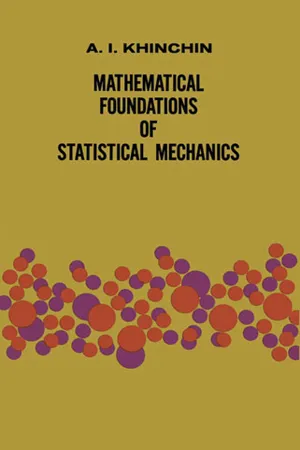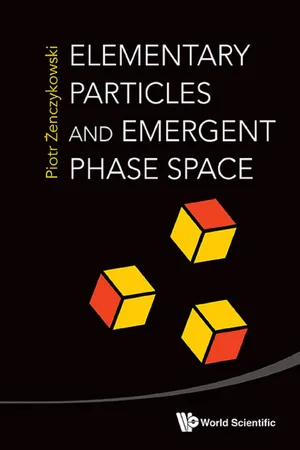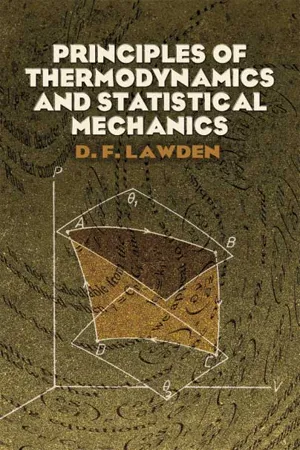Physics
Phase Space
Phase space in physics refers to a mathematical space in which all possible states of a system are represented, with each state corresponding to a unique point in the space. It is often used to analyze the behavior of dynamic systems, such as particles or waves, by plotting their positions and momenta. Phase space provides a comprehensive way to study the evolution of a system over time.
Written by Perlego with AI-assistance
Related key terms
6 Key excerpts on "Phase Space"
- A. Ya. Khinchin(Author)
- 2013(Publication Date)
- Dover Publications(Publisher)
CHAPTER IIGEOMETRY AND KINEMATICS OF THE Phase Space
3. The Phase Space of a mechanical system. In the statistical mechanics it is convenient to describe the state of a mechanical system G with s degrees of freedom, by values of the Hamiltonian variablesq1 , q2 , , qs ; p1 , p2 , , ps. The equations of motion of the system then assume the “canonical” form(1)where H is the so-called Hamiltonian function of the 2s variables q 1, , ps (we always shall assume it not to depend on time explicitly). The function H(q i , p k ) is an integral of the system (1). Indeed, in view of this system of equations,Since system (1) contains only equations of the first order, the values of the Hamiltonian variables q 1 , ⋅⋅⋅ , p s given for some time t = t 0 , determine their values for any other time t (succeeding or preceding t 0 ).Imagine now a Euclidean space Γ of 2s dimensions, whose points are determined by the Descartes coordinates q 1 , ⋅⋅⋅ , p s . Then to each possible state of our mechanical system G there will correspond a uniquely determined point of the space r, which we shall call the image point of the given system; the whole space Γ we agree to call the Phase Space of this system. We shall see that, for the purposes of the statistical mechanics, the geometrical interpretation of the set of all possible states of the system by means of its space, appears exceedingly fruitful and receives a basic methodological significance.Since the state of the system at any given time determines uniquely its state at any other time, the motion of the image point in the Phase Space which represents the changes of state of the given system depending on time is uniquely determined by its initial position. The image point describes in the Phase Space a curve which we shall call a trajectory. It follows that through each point of the Phase Space there passes one and only one trajectory, and the kinematic law of motion of the image point along this trajectory is uniquely determined.- eBook - ePub
- Piotr Żenczykowski(Author)
- 2013(Publication Date)
- WSPC(Publisher)
PART 3 Phase Space AND QUANTUM“I do not believe that a real understanding of the nature of elementary particles can ever be achieved without a simultaneous deeper understanding of the nature of spacetime itself.”Roger Penrose [130]Passage contains an image Chapter 9 Phase Space and Its Symmetries
At the end of the last chapter we stressed the need to seek connections between the classical description of the world and its quantum aspects. However, as physics touches reality only through its descriptions, even within the classical description we have different formalisms at our disposal.In particular, we have the Lagrangian and Hamiltonian formulations of classical mechanics. In the Lagrangian approach, a fundamental concept is that of a position of a body in the ordinary 3D space. This position changes with time, and is therefore described by vector function x(t). When dealing with a particular problem, this function is found by solving a second-order differential equation. The motion of the body (i.e. its velocity or momentum) is viewed here as a ‘coincidental’ change of position: it is calculable within the formalism as the first derivative of x(t), but is not really considered to be a fundamental concept.On the other hand, in the Hamiltonian formalism, both position and momentum of a body are treated as equally fundamental vector functions x(t) and p(t), with the state of a body at a given time being specified by the point (x(t), p(t)) in the 6D Phase Space. Evolution of the system in time is then given by the Hamilton equations of motion which are simpler (first-order only) differential equations connecting two originally independent functions of time: positions and momenta. We recall now from Sec. 4.1 - eBook - ePub
- Utkir A Rozikov(Author)
- 2018(Publication Date)
- WSPC(Publisher)
Chapter 4
Billiards and physics
Mathematical billiards arise in many problems of physics. For example, one may consider billiards in potential fields. Another interesting modification, popular in the physical literature, is the billiard in a magnetic field[11 ],[110 ],[111 ]. Here we give some simple examples from physics which are related to billiards.4.1Phase Space
Consider the movement of some system of objects - particles, bodies, etc. Let us add to space of configurations {x} their speed vectors {v}), i.e. we will consider various couples {(x, v)}. The received set of couples (x is situation, v is speed) is called Phase Space of system, and the point (x, v) representing the system is called the phase point of the system. In other words, Phase Space is the set of various states of the movement of the system.Example 4.1.•Consider a point x on the real line R 1 which can move on it with arbitrary speed v. Then the Phase Space will be R 2 = {(x, v)}.•The Phase Space of two independent points on R will be a 4-dimensional space.A process is called determined if all its future states and all its past are defined by a state at the given moment. Such processes are, for example, processes of radioactive disintegration and reproduction of bacteria. There are also nondeterministic processes: such is the movement of particles in the quantum mechanics (neither the past, nor the future are defined by the present state) or distribution of heat (the future is defined by the present, and the past is not defined by the present).The classical mechanics considers of the movement of systems whose future and the past are defined by initial states and speeds of all points of system, i.e. considers the determined processes. In each time point t0 the mechanical system S is in the state x(t0 ) and has a concrete vector v(t0 ) of speed, a phase point of this system is (x(t0 ), v(t0 )) which completely characterizes evolution of system as in the past, at all t < t0 , and as well as in the future, at all t > t0 . Knowing the one-unique state S(0) = (x(t0 ), v(t0 )) of the movement of the system at the time t0 , it will be possible to define state of the movement of this system in all time is given by {S(t)} = {(x(t), v(t)), −∞ < t < ∞}. The set of states of the movement {S(t)} is the set of all phase points (x(t), v(t - Alexandre Zagoskin(Author)
- 2015(Publication Date)
- Teach Yourself(Publisher)
In many cases these equations are easier to solve than the Lagrange equations. What is more important to us is that they form a vital link between quantum and classical mechanics.Hamilton’s equations describe the evolution with time of the state vector in a 2M-dimensional Phase Space of our system. One cannot easily imagine this, but some geometrical intuition based on our lower-dimensional experience can be actually developed with practice. For example, you can draw the phase trajectories in each of the M planes (qi ,pi ) and consider them in the same way one does different projections of a complex piece of machinery in a technical drawing.We will try to show how it works on another example – the last in this chapter – of those notions from classical physics, which turn out to be not that much different from their quantum counterparts. Statistical mechanics, statistical ensemble and probability distribution functionOne of the simplest and most useful model systems considered by classical physics is the monoatomic ideal gas – a collection of a very large number N of identical material points, which do not interact with each other. This model helped establish the fundamentals of statistical mechanics – the aspect of physics that explains, in particular, why water freezes and how an electric heater works. We already know that the state of this system can be completely described by a state vector in a 6N-dimensional Phase Space (or, which is the same, a single point in this space – the end of the state vector; see Figure 1.9 ).As we know, the state vector determines all the positions (in real space) and all the momenta of all N gas particles. A single cubic centimetre of gas at normal pressure and zero degrees Celsius contains about 2.7 × 1019 molecules. Therefore the state vector contains a lot of unnecessary and unusable information. It is unusable, because even if we had all this information, we could never solve 6 × 2.7 × 1019- eBook - ePub
- Luca Peliti(Author)
- 2011(Publication Date)
- Princeton University Press(Publisher)
Let us suppose that the system is energetically isolated so that there are no exchanges of energy between it and the external environment. At each instant, the state of the system can be described by giving each particle's position r and momentum p : 6 N scalar variables in total. These identify a point, the system's representative point, within a 6N-dimensional space, called the Phase Space. The evolution of the system is represented by the motion of the representative point within this space and is described by Hamilton's system of 6 N differential equations of motion. If we denote the system's Hamiltonian by H : these equations have the expression Let us denote the generic point of the space phase by x = (p 1, r 1,…, p N, r N). With the passage of time, the system's representative point moves along a trajectory x = x (t ; x 0), identified by the initial condition x (0; x 0) = x 0 = (p 1 0, r 1 0,…, p N 0, r N 0). Generally speaking, this trajectory is extremely complicated. The only thing we can state a priori is that, if the system is isolated, it lies entirely on the surface defined by the equation The Hamiltonian's constant value E can be identified with the system's internal energy. Strictly speaking, for a system of 6 N equations of motion, there exist 6 N – 1 integrals of motion, which define a line in Phase Space along which the system must move. To a very large extent, however, these integrals cannot be measured or theoretically predicted, because a small disturbance to the system causes their values to vary greatly. In a system composed of many particles, a small (experimentally imperceptible) shift of each particle corresponds to a large shift of the system's representative point in Phase Space. It is obvious that quantities that change a lot due to a shift of this kind cannot be relevant to a thermodynamic description of the system - D. F. Lawden(Author)
- 2013(Publication Date)
- Dover Publications(Publisher)
CHAPTER 5Quantum statistics
5.1 Quantization of Phase Space
Suppose a gas molecule is prepared in a prescribed pure quantum state ψ by the observation of the values of a maximal set of mutually compatible observables. Immediately afterwards, its x -coordinate is observed to have the value x. If this procedure is carried out a very large number of times (i.e. preparation in state ψ and subsequent measurement of x), unless x happens to be one of the observables used to define ψ (i.e. unless ψ is an eigenstate of x), the observed values of x will not all be identical, but will be spread about some mean value . Let Δx be the standard deviation measuring the extent of this departure from the mean. Next, suppose the x-component of linear momentum p x of the molecule is similarly observed a large number of times for the state ψ and let Δp x be the standard deviation for the sequence of values obtained. Then, it can be proved to be a consequence of the basic principles of quantum theory that(5.1.1)where h is Planck’s constant (6.626 x 10-34 Js). This is Heisenberg’s Uncertainty Principle.If, therefore, we construct a Phase Space by setting up rectangular Cartesian axes Oxp x in a plane and try to represent the state of the molecule by a point with coordinates (x, p x ), the position of this point will be uncertain, but can be expected, with high probability, to lie with its x-coordinate in the range ( ) and its p x -coordinate in the range ( ), i.e. within a rectangle of area 16Δx Δp x . According to the inequality (5.1.1), this area cannot be smaller than 4h /π, i.e. approximately h.
Index pages curate the most relevant extracts from our library of academic textbooks. They’ve been created using an in-house natural language model (NLM), each adding context and meaning to key research topics.





